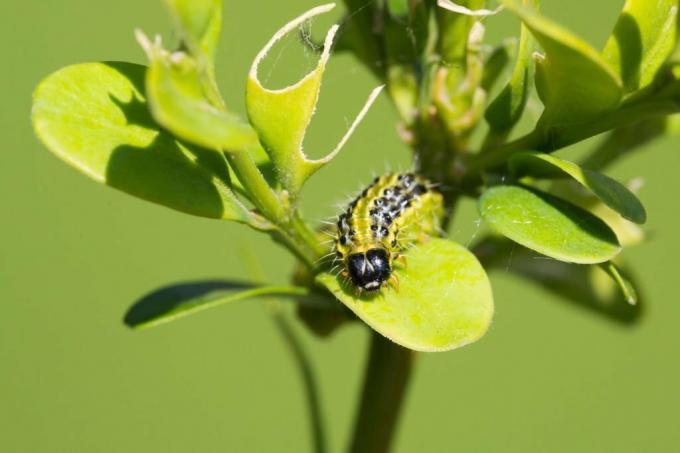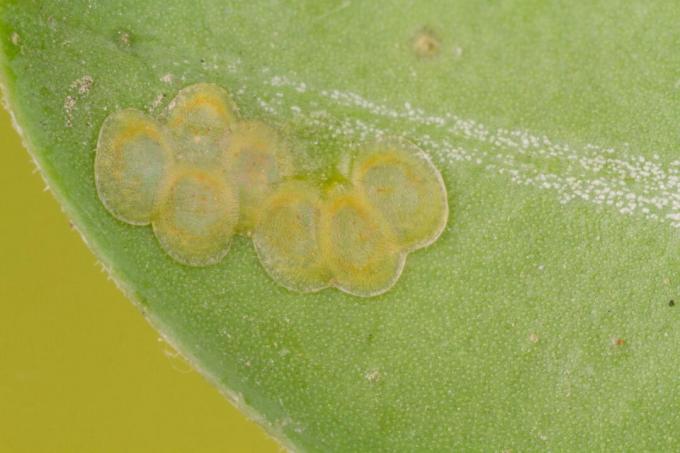Recognizing the moth flight of the box tree moth is the first step to a successful and early control. We introduce you to the butterfly.

The moth of the Box tree moth (Cydalima perspectalis) is unlike the annoying Moth caterpillars pretty to look at. Attracted by the scent of the butterfly lilac, in rare cases it can also be observed during the day, although it prefers the dark hours of the night. We have compiled everything for you that you need to know about the little butterfly.
contents
- What does the boxwood moth look like?
- When can the boxwood moth butterfly be found?
- Way of life and life cycle of the box tree moth
The sighting of a boxwood moth means that it will soon be possible to lay eggs and thus the appearance of the hungry caterpillars Boxwood (Buxus) will come. So that you can recognize it safely, we explain and show what the boxwood moth's butterfly looks like, when it can be found and what the life cycle of this small butterfly is like.

What does the boxwood moth look like?
The box tree moth is a small butterfly with a wingspan of just 4 to 4.5 centimeters. This roughly corresponds to the top two links on your index finger. If the wings are spread out, they run obliquely backwards. Both the hind wings and the fore wings end semicircular. The base of the wings is hairy, the compound eyes are black and the antennae are long and thin. Like all butterflies, the boxwood moth has a proboscis that it carries rolled up under its head when it is not needed to drink flower nectar. There is one thing with the coloring of the wings: the most common are white wings, the edges of which are lined with a brown ribbon. This band is broken through at the front edge by a white spot. More rarely, however, are white-beige, completely brown, almost black and even dark purple shimmering shades of color. The color of the abdomen is always adapted to the color of the wings and therefore also ranges from pure white to black.

When can the boxwood moth butterfly be found?
The moth is predominantly nocturnal. During the day it stays in the resting position on the underside of the leaves of plants in the vicinity of the box tree. If you want to know exactly when butterflies are in your own garden, you should go with one Pheromone trap for boxwood moth such as the Plantura Moth trap make his own observations. The installation is most likely to be successful in June and August, in very warm years a butterfly can be trapped in May and July. The knowledge of the butterfly flight is an important part of a successful one Combating the borer, because during the multi-day butterfly flight, mating and oviposition take place, so that the appearance of the first voracious larvae can be predicted with great precision.
Once the moths have been discovered, control is usually necessary. It pays to act quickly. The bacterium is extremely effective in combating it Bacillus thuringiensis, that also in our Plantura borer-free XenTari® is included. The agent is used when the caterpillars have hatched and then stops eating immediately.
Way of life and life cycle of the box tree moth
Depending on the weather and temperature, two to three generations occur in Europe each year; overwintering occurs in the caterpillar stage. From about mid-March to May, the larvae go through several stages of development, grow up to five centimeters in size and eat hard on the boxwood. If they were initially in the protected interior of the shrub, they are now gradually penetrating the periphery as well.

After the last of the six caterpillar stages, pupation and then hatching of the butterfly follow. This only lives for about eight to nine days, during which it mates and lays eggs. If it is the last generation of the year, the hatched caterpillars overwinter in the third or fourth instar, pupating in webs of caterpillar silk in the bush, until they become active again in March at temperatures above 12 ° C and the cycle starts again begins. In relatively cool Germany, there are usually two generations. The development cycle is summarized again in the following table.
| month | April | May | June | July | August | September |
|---|---|---|---|---|---|---|
| State of development | Caterpillars (overwintered) | Cocoons | Moths, eggs | Eggs, caterpillars | Cocoons, moths | Butterflies, eggs, caterpillars |
| generation | Generation last year | Generation 1 | Generation 2 |
Because the development of the butterfly from egg to butterfly can accelerate rapidly in warm temperatures, these figures are only rough guidelines.

How do you Boxwood moth caterpillar You can find out what their damage looks like in this special article.
